Medical Software Development in 2025: What Healthcare Providers Need to Know
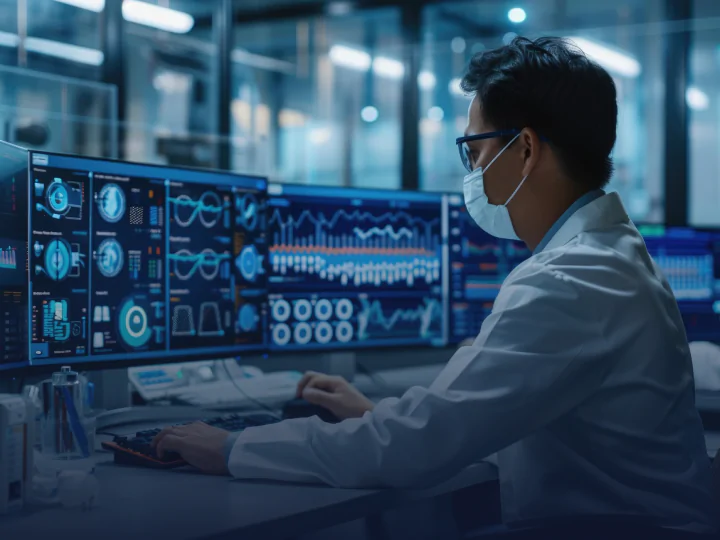
Today, medical software development fundamentally changes the healthcare sector. But why didn’t all the digital tools introduced in your hospital or clinic live up to your expectations?
It’s time to figure out how to get software in the medical field that will benefit you, your staff, and your patients. We, the Riseapps team, will demonstrate through our case studies how you can empower your medical facility with advanced tech solutions.
Software Development for Medical Facilities: Top 12 Product Types
Take a brief look at medical software solutions that enhance the core processes of hospitals, clinics, medical practices, and more.
1. Electronic Health Record (EHR) Software
Electronic health record (EHR) software serves as a digital version of a patient’s medical chart and provides secure and efficient management of patient information. EHR solutions give healthcare providers quick access to patient data, which enhances clinical decisions.
You can get acquainted with EHR software using one of our projects as an example.
The Wound Pros EHR system
The Wound Pros is a specialized electronic health record (EHR) system for wound care with integrating image capture, data management, and reporting functionalities. The client turned to us seeking to implement a new approach to treat non-healing wounds due to improved data visualization, document flow, and medical decision-making.

One of the challenges of the project was designing a cross-platform, scalable, and easy-to-manage system architecture. The project included the development of a multi-component medical data management system, a web-based platform for medical facilities, and a mobile app for nurses. Handling complex wound assessment data and integrating a new platform with existing healthcare systems were also in focus.
Riseapps Solutions:
- Scalable system architecture for a unified cloud-based automated system that is suitable for multiple devices, including mobile, tablet, and desktop
- 120+ new wound care management modules
- Mobile app for nurses with a tracking system for managing patients, scheduling appointments, automatically generating routing data, and real-time communication
- Web-based platform for hospitals and clinics to manage patients, report, track orders/deliveries, and communication
- Cloud-based wound data management automated platform
- Seamless integration with existing software systems
- Secure data encryption and access controls
Medical software developers of Riseapps have designed the EHR platform containing such elements









The client got a new comprehensive platform, compatible with all types of devices, which allows medical professionals, management teams, and facilities to treat and manage wounds, spending 3 times less time due to streamlined workflows and interoperability.

The highlight of this EHR Platform is its 100% HIPAA compliance, which we always provide in healthcare software development for US-based companies. Software development for the healthcare industry is unthinkable without regulatory compliance. When implementing digital transformation in modern healthcare, the protection of sensitive medical data traffic should be prioritized. In this regard, it is appropriate to mention that ISO 27001:2022, ISO 31000, and HIPAA BAA-certified professionals implement Riseapps projects in the healthcare environment.
2. Hospital Management Software
Hospital management software integrates various administrative, clinical, and financial processes within the hospital environment. This software increases efficiency, improves patient care, and supports data-driven decision-making through features like real-time data tracking and advanced analytics.
3. Medical Diagnosis Software
Medical diagnosis software utilizes algorithms and data analysis to assist in diagnosing diseases. It processes extensive medical data to provide valuable insights to clinicians, which aids in accurate disease identification and treatment planning.
4. Medical Imaging Software
Medical imaging software is crucial for visualizing and analyzing medical images. This software supports specialists by providing capabilities for interpreting complex imaging data, which is vital for accurate diagnosis and treatment planning.
As our practice shows, tools for making and managing high-quality standardized photos often require integrations with electronic medical records (EMRs) and other information bases. In one of our projects, we helped healthcare experts get a high-tech solution for working with images integrated with medical records. We’ll share with you the main points of such development.
RxPhoto imagery tool for healthcare professionals
RxPhoto is a medical imagery software used in plastic surgery, dermatology, and other fields. The client’s request to us was to improve a clinical photo management and storage mobile app.

Project challenges included changing the app’s architecture and tech stack, as well as the expanding app’s functionality and camera support capabilities.
Riseapps Solutions:
- App redesign by creating a new architecture and rewriting the iOS app codebase in a different programming language
- Implementing functionality that allows physicians to take photos with the required parameters using on-screen positioning templates and conveniently manage the captured images
- Expanding camera support capabilities by enhancing external accessories connection algorithm and improving camera protocols
- Ensuring data encryption and HIPAA compliance
- Integrations with EMRs like Streamline, eClinical, and Greenway, etc.

As a result of the project, the client launched the premier mobile medical imaging software that helps doctors make informed decisions and raise consultation conversion rates.

The mobile medical photography system works perfectly, and Riseapps continually distinguishes itself with solid expertise and responsiveness. They’re an excellent resource for any healthtech provider. We have been working with Riseapps for more than 2 years, and we’re very happy.
Chris Cabell, CEO
5. Medical Device Software
Medical device software includes medical embedded systems (often based on IoT) and Software as a Medical Device (SaMD). These systems are integral to modern medical devices, providing essential functionalities such as patient monitoring and device operation management.
Medical device software development has significant potential to boost digital healthcare. This field of software development combines the best of both worlds. On the one hand, there is tangible technical progress in medical devices. Every technological innovation in this area creates new opportunities for medical device software development. Medical devices are becoming more autonomous and getting more functionality to engage in data collection, and data storage processes.
On the other hand, embedded coding languages are developing. A professional community of engineers specializing in software solutions for embedded medical systems generates new tools that enable healthcare institutions to get more from modern medical devices.
Today’s digital health should not have gaps. Therefore, it is worth mentioning such an area of medical device software development as the modernization of obsolete medical device software. A medical device can still be serviceable and functional but be controlled by outdated or unsupported software systems.
In such situations, there are many drawbacks. First of all, it concerns the vulnerability of the data. It is also impossible to implement innovative solutions, which require the inclusion of every medical device that is in a certain hospital unit.
That is why medical device software development can extend the life of a medical device. Re-developing medical device software is a particularly pressing task when it comes to an expensive or very common type of medical device.
In the medical devices industry, a specific internationally recognized standard, ISO 13485, for quality management systems (QMS), is in effect. It outlines requirements for the design, development, production, installation, and servicing of medical devices.
6. Telemedicine Software
Telemedicine software facilitates remote clinical services, offering features like video conferencing and electronic prescriptions. This technology extends healthcare access, particularly in underserved areas, by allowing patients to receive care remotely.
Such software products are in demand in various healthcare segments. Riseapps professionals, for example, helped clients create a virtual emergency clinic and a mental health platform. You can learn more about the specifics of telemedicine software on the example of our projects.
Kego virtual urgent clinic
Kego is a telemedicine urgent care clinic where patients can see doctors through video conferences via web apps or mobile apps.

The main challenge of the project was clinical software development from scratch with high-quality video conferencing, convenient visit management, and a payment system. In turn, HIPAA compliance had to be ensured in the context of intensive data exchange in different formats (video calls, text, voice, and video messages).
Riseapps solutions:
- A combination of several software products: a website, an iOS app for doctors, and an iOS app, an Android app, and a web app for patients
- Fine-tuned functionality, including robust video chatting, fast appointments, easy documentation
- Implemented real-time data syncing capabilities.
By building the virtual clinic, клієнт raised user satisfaction, increased efficiency in home health management, and enhanced data security and reliability, achieving 100% HIPAA compliance.
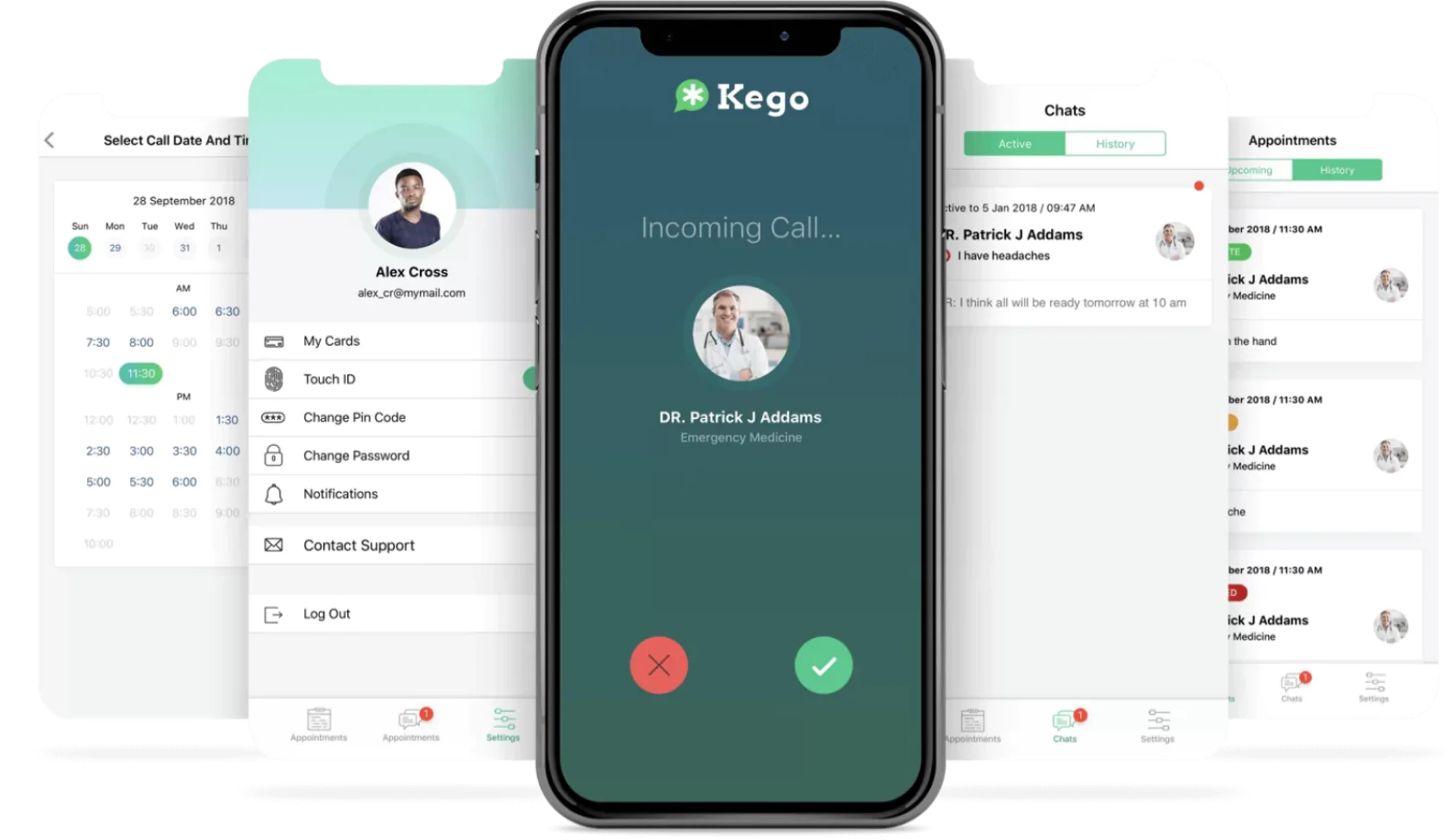
We hired Riseapps to build our website and mobile apps, both the front- and backend. Riseapps managed the project well, communication was easy, and they were very responsive and helpful in easing obstacles as our project grew larger and larger.
Things were done the way I expected and envisioned. They adapted quickly to any requested changes.
Maher Alrahamneh, CEO
Skinpick mental health platform
Skinpick is a self-help app for individuals with disorders, providing tracking, educational resources, and community support. The client’s initial request was to redesign the existing web mental health platform, making it more mobile-friendly and expanding its functionality.
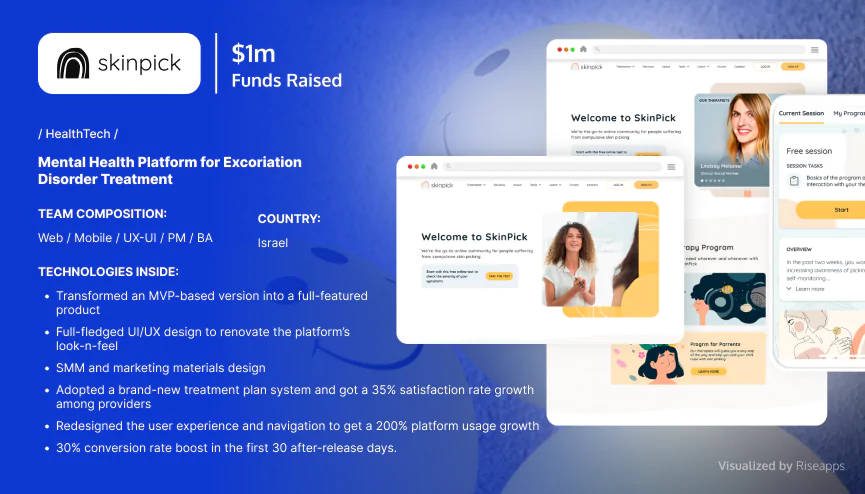
The project aimed to enhance user engagement by making the platform lightweight, fast-loading, and accessible across multiple device types. It was necessary to expand functionality by adding significantly more client-focused tools and enhancing interactivity to reach the client’s business goals.
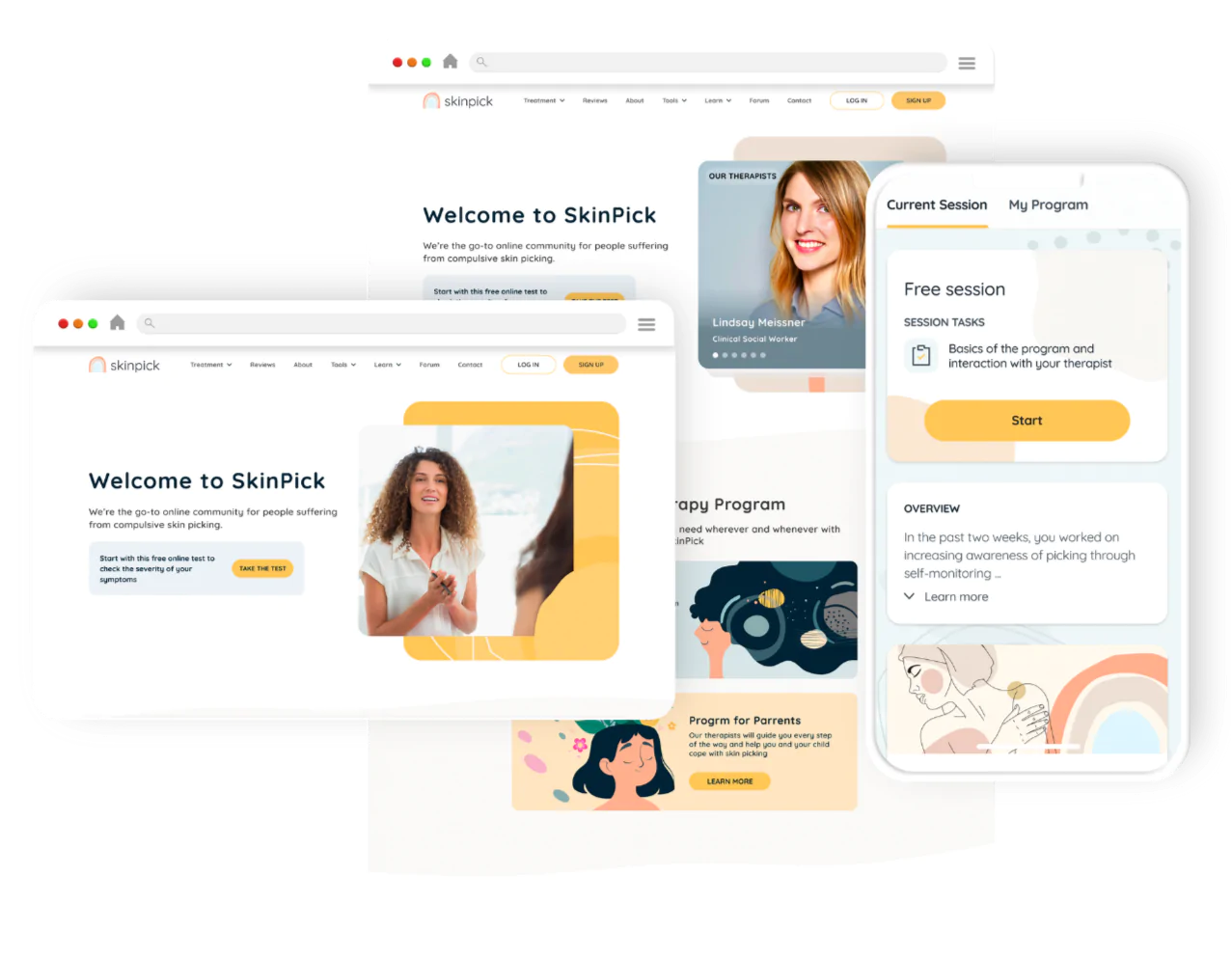 Riseapps solutions:
Riseapps solutions:
- Transformation of a desktop-only legacy website into a cross-platform mobile-first system
- Implementing data-driven patient care
- Brand new mobile-first UI/UX platform design
- Creating a customizable session builder
- A multiple increase in the number of built-in therapy tools
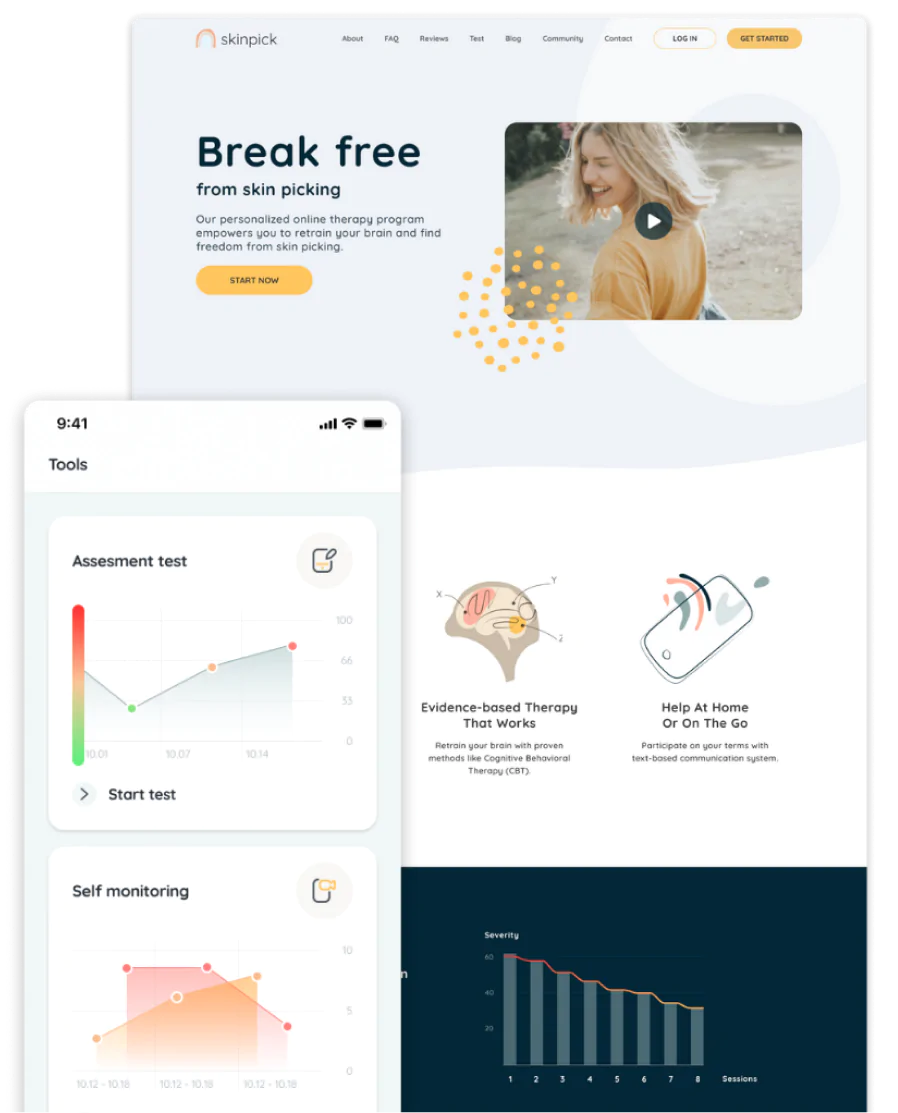
With the redesigned platform, the client gained a 30% increase in web conversion rate, 2x platform usage boost, 45% user satisfaction rate growth, and 5x more available therapy tools.
Riseapps managed to deliver functional and aesthetically pleasing solutions that accurately convey the client’s brand and products. Their creativity and experience in the field enabled them to bring the client’s ideas into life. They communicated effectively, establishing a smooth workflow.
Eran Price, COO
7. Remote Patient Monitoring (RPM) Software
Remote patient monitoring software enables healthcare providers to monitor patients outside conventional clinical settings. By collecting data on vital signs and other health metrics, RPM enhances patient management and reduces the need for in-person visits.
The track record of Riseapps includes examples from which you can imagine the specifics of software products of this type. In one of these cases, we created a standalone RPM platform, and in the second – an RPM module for a comprehensive patient care tool.
InteliWound wound management software
InteliWound is a platform for rapid and cost-effective wound care delivery. The client engaged us to create a system that helps the medical staff monitor and clinically assess wounds, prescribe treatment, order supplies, and more.
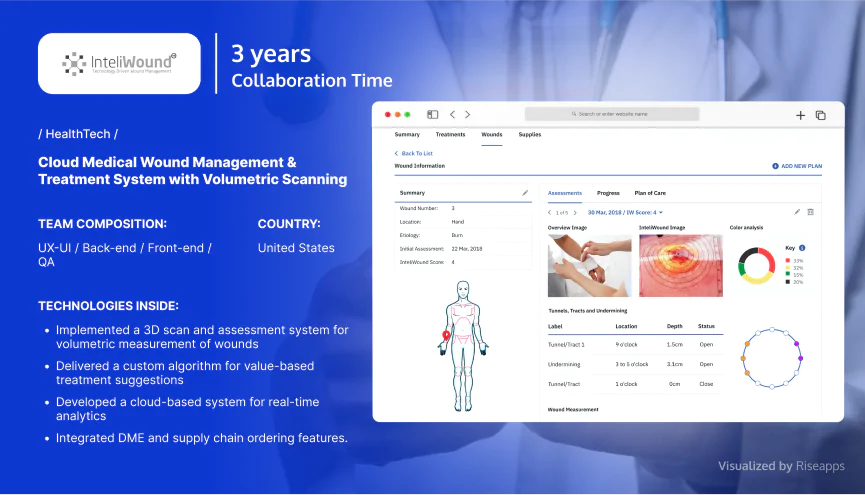
The wound management platform is targeted to facilitate compliance with complex regulations on wound care while reducing the load on clinical personnel and decreasing the costs of wound care.
Riseapps solutions:
- A highly scalable platform based on Amazon Web Services that supports the operation of mobile iPad app and web portalє
- Functionality of 3D scanning and assessment with advanced photo capture and volumetric measurement of wounds
- Custom algorithm with a set of treatment instructions
- Enhanced real-time oversight
- Integration of DME and supply chain ordering functionality
By a HIPAA-compliant cloud platform, the client provides proper care of patients in the US, achieving improved treatment outcomes, reducing the frequency of treatment visits, and saving funds for medical organizations.
CareHalo: An RPM module for the top-notch patient care platform
CareHalo is a leading multifunctional platform for chronic disease management. The famous US healthcare provider came to us with the need to build an RPM web app as a module for its complex software system.
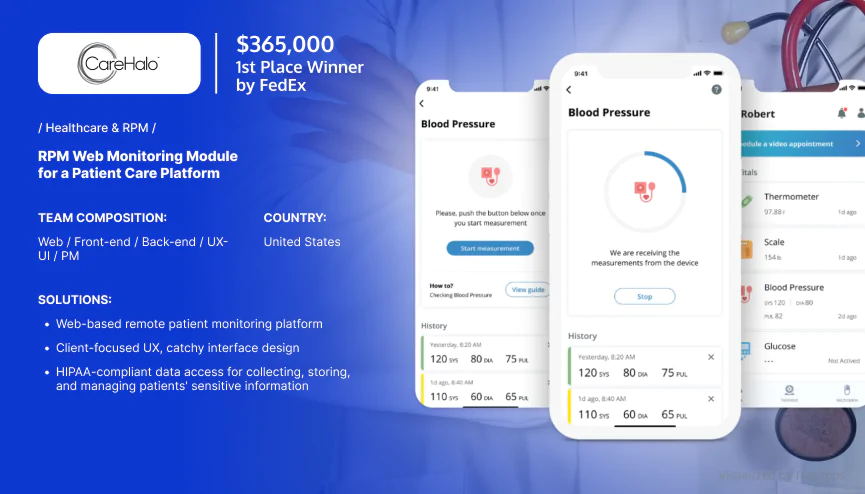
The main challenge of the project was to implement functionality to maintain a stable workflow for physicians and nurses who deal with a multitude and variety of cases. The platform also requires handling and protecting large amounts of vital and confidential data.
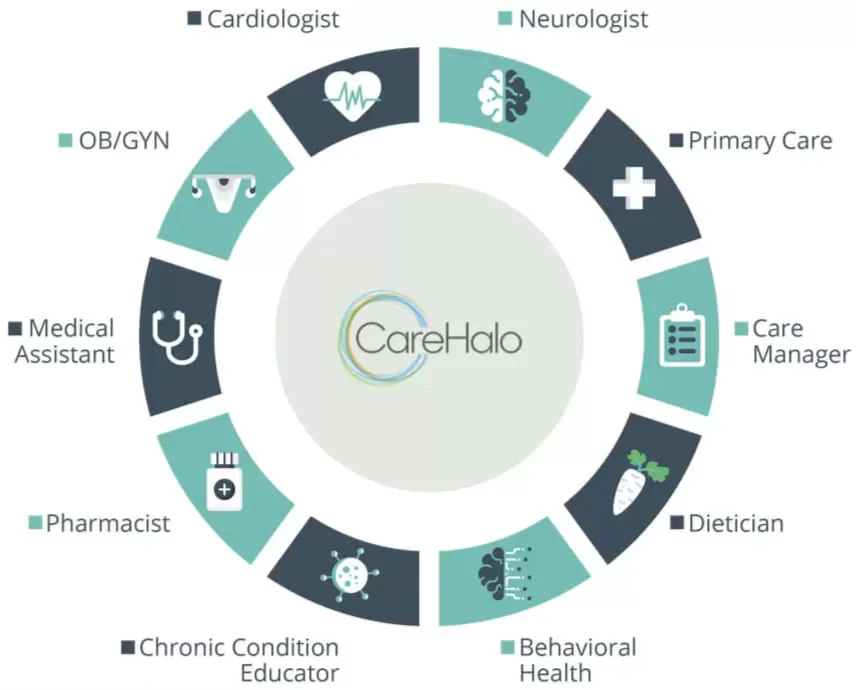
Riseapps solutions:
- Accurate adherence to medical care instructions in the web app
- Introduction of ‘medical assistant’ and ‘provider’ roles to RPM app. This approach allows to reduce to zero the risks of missing a case requiring intervention
- Full-fledged toolkit for healthcare professionals to monitor patients’ conditions and collect, store, and manage medical data. The introduced “Case cards” feature contributes to a seamless workflow
- Refined monitoring algorithms, the use of which guarantees that no case requiring medical intervention will go unnoticed and patients receive the necessary attention
- Ensuring HIPAA compliance. All electronic protected health information (ePHI) is secured following industry regulations and best practices
Advanced RPM module for medical care according to the highest standards now reliably serves to predict and prevent situations requiring emergency intervention.
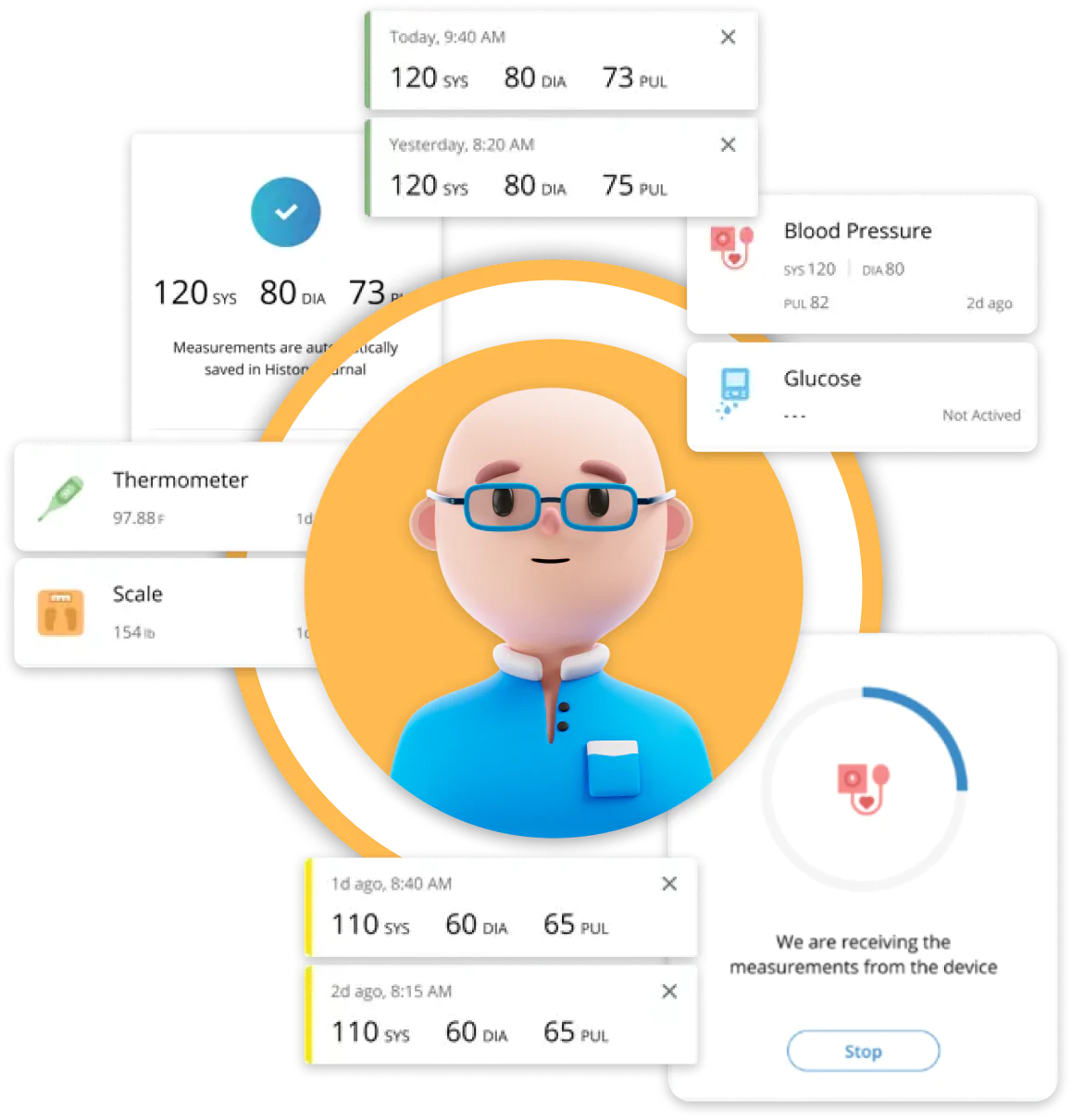
8. Mobile Health (mHealth) Apps
mHealth Apps provide mobile solutions for health monitoring and management, integrating with devices like smartphones and wearables to deliver personalized healthcare services. These apps are pivotal in managing chronic conditions and improving patient engagement.
It is feasible for such a “pocket clinic” to have rich functionality.
Here’s what it looks like on the example of the mobile brain health platform we helped create for the clinic founded by Daniel G. Amen, M.D.
Amen Clinics` mobile brain health platform
The software we have developed for Amen Clinics is a mobile brain health coach solution. This client specializes in brain health and treats a broad spectrum of neuropsychiatric and behavioral disorders.

Before starting cooperation with us, Dr. Amen’s team was already using a mobile app. However, it no longer met their needs due to outdated architecture and functionality, as well as poor performance and scalability. In particular, the legacy app was not intuitive for patients and lacked modern features like appointment scheduling or gamification.
The initiating request of Amen Clinics was to audit the existing code to eliminate technical debt and, if necessary, to rebuild the mobile app for brain health coaches. After a code audit, technical debt assessment, and project discovery, the client preferred to develop a mobile app from scratch with new architecture, infrastructure, and functions.
Riseapps undertook to build an app architecture and infrastructure that will support scalability, high loads, and advanced functionality. The tight timing is also worth noting because the client asked to kick off the project ASAP and launch a new mobile app in 6-8 months.

In addition to creating a new architecture, we focused on the app’s functionality. Our medical software developers have divided it into two parts, for therapists and patients, and have provided an advanced set of features.
Riseapps delivered a mobile app from scratch in 6 months. The app`s enriched functionality, including 30 new added features, gamification processes, tools, actions, and integrations, drives higher user engagement and retention, as well as increased conversions and revenue.
9. E-prescribing and Medication Management Software
E-prescribing software streamlines the prescription process by allowing the electronic sending of prescription orders directly to pharmacies. This technology improves prescription accuracy and enhances patient safety by reducing medication errors.
Medicine delivery software makes healthcare more affordable. Telepharm platforms & marketplaces allow individuals to quickly receive medications according to personalized plans and economically manage their costs. Here you can read more about how we helped our client create such medication management software.
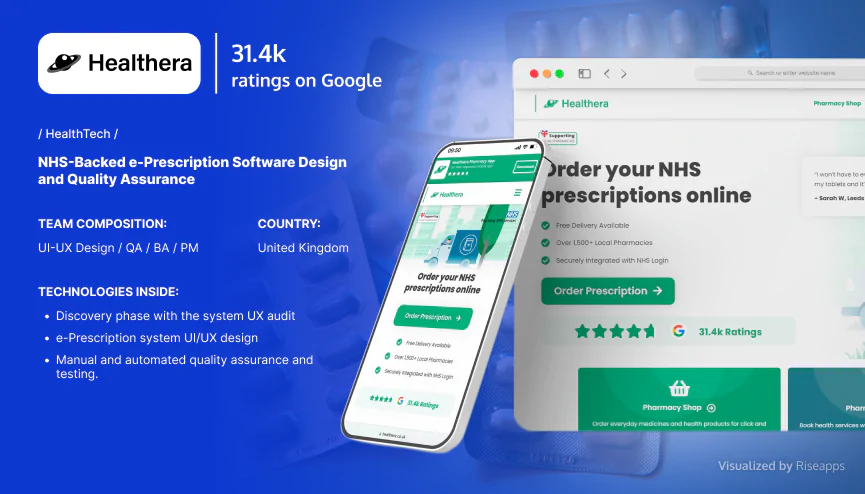
10. Healthcare Learning Management Systems
Healthcare learning management systems (LMS) are platforms that facilitate the delivery and tracking of educational content in healthcare settings. LMSs support compliance training and professional development for healthcare personnel, ensuring adherence to industry standards.
11. Laboratory Information Management Systems (LIMS)
LIMS manages laboratory operations, from sample handling to data analysis. These systems are essential for enhancing laboratory efficiency and accuracy, supporting complex analytical processes in medical research and diagnostics. Also, this area of software development may include software solutions for clinical trials, medical device software for laboratories, etc.
12. Healthcare Regulatory Compliance Software
Healthcare Regulatory Compliance Software helps healthcare organizations adhere to industry regulations and standards. This software is crucial for maintaining patient safety and quality of care by ensuring compliance with legal and ethical requirements.
AI in Medical Software Engineering
Artificial Intelligence (AI) is significantly reshaping the landscape of digital health, offering unprecedented advancements in patient care, diagnosis, and treatment planning.
Here is a case study from Riseapps to learn how to harness AI to develop cutting-edge solutions that enhance healthcare delivery and operational efficiency.
Black Doctor 24/7: AI Telehealth Platform
Black Doctor 24/7 is the pioneering specialized telemedicine platform for wound care. The founder is Dr. Bill J. Releford, a renowned podiatric surgeon specializing in diabetic amputation prevention. The Black Doctor`s mission is to decrease amputation rates among African Americans, especially in underserved and under-resourced communities.
In 6 months, the client needed to deliver an MVP of a HIPAA-compliant telemedicine system with AI assistance and all-round functionality for both physicians and users.
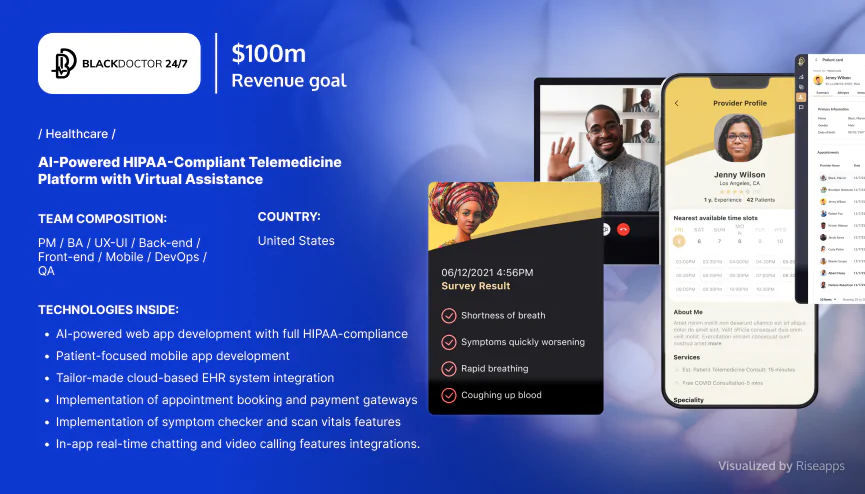
Riseapps solutions
- Rich functionality for doctors, including wound reporting, appointment scheduling, supplies ordering/tracking, and on-the-go telemedicine features
- An intuitive and engaging set of patient-centric features, including convenient pre-screening via Amina AI assistant, appointment booking, automated self-assessment, etc.
- Real-time chatting and video calling
- An AI-driven symptom checker service to enhance patient care
- ISO-compliant multi-factor authentication to advance data protection
If summing up the project in a nutshell, then the set goals were achieved. The time to market for a cross-platform AI-powered app was only 6 months. An external certified vendor verified 100% HIPAA compliance for the telehealth system.
The Black Doctor team provides 24/7 remote humanized patient care with AI-based virtual assistance via the telemedicine platform. Using the platform’s capabilities, specialists accelerated wound assessment and diagnosis and decreased patient service time, as well as cut medical care delivery overheads by 40%.
Where to Start Using AI in Your Medical Software
Understanding the challenges faced by healthcare software product owners in assessing the applicability of AI features, Riseapps provides an AI R&D Prototyping service. This service includes technical feasibility checks by our AI engineers, the development of a working Proof-of-Concept with a minimal UI interface, and detailed cost projections for MVP development. The cost of our AI R&D Prototyping service package starts at $15,000, ensuring that our clients can make informed decisions about integrating AI solutions into their operations.
Core Compliance Standards for the Software in the Medical Field
Security and compliance are paramount in the healthcare industry due to the sensitive nature of health data. Professionals in this field of software development, in addition to advanced knowledge of programming languages, cloud solutions, development processes, etc., need to have a thorough knowledge of vital rules that healthcare providers follow. This section explores the key regulations and standards that govern security and compliance in medical software development services.
Here are the basic standards that apply when providing software development services in the healthcare sector.
HIPAA
The Health Insurance Portability and Accountability Act (HIPAA) governs the protection of sensitive healthcare data in the U.S.
HITECH
The Health Information Technology for Economic and Clinical Health (HITECH) Act, enacted in 2009, strengthens the enforcement of the HIPAA and promotes the adoption and meaningful use of health information technology (HIT), especially Electronic Health Records (EHRs).
GCP
Good Clinical Practice (GCP) is an international quality standard for clinical trials involving human subjects, including designing, conducting, recording, reporting, etc.
CCPA
The California Consumer Privacy Act (CCPA), effective in January 2020, is a California law that enhances privacy rights and consumer protection for residents of California. It regulates how businesses collect, use, and share personal data, including health data.
GDPR
The General Data Protection Regulation (GDPR) enhances the protection of personal data of individuals within the European Union.
ISO
ISO/IEC 27001:2022 is an international standard that outlines the best practices for an information security management system (ISMS).
HITRUST
The HITRUST Common Security Framework (CSF) is a comprehensive framework that integrates various standards and regulations (including HIPAA, ISO, and NIST) to provide a unified approach to managing information security and risk in healthcare.
FDA
The U.S. Food and Drug Administration (FDA) provides guidelines that cover the development and use of medical devices software.
IEC
IEC 62304 is a functional safety standard that specifies life cycle requirements for medical device software.
Adhering to the above standards and regulations in software development services ensures the security and compliance of software products and enhances reliability and trustworthiness in healthcare. That is why Riseapps provides custom software development services for healthcare providers by ISO 27001:2022, ISO 31000, and HIPAA BAA-certified specialists.
Medical Software Development Process
Step 1. Project Discovery
Starting the project with discovery is an appropriate moment to align the project’s goals with the specific needs of stakeholders and end-users. That’s why at Riseapps, we always recommend that our clients consider conducting a Project Discovery phase before starting medical software development.
Within Project Discovery, together with the client, we carry out the following five main steps:
Define business goals.
We gather and analyze input data to determine the project’s goals, scope, and deliverables. The outcomes of this step are the creation of the project backlog and the identification of risks.
Clarify success criteria & build a product vision.
The task of this step is to clarify and agree on the measurable success criteria for project stakeholders and end-users of the software product. As a result, we get a product vision and project success criteria.
Map user journeys.
We visualize the product user flow. Interactive prototypes and user interface design appear after this step.
Create a product architecture.
This step is intended to approve a detailed product architecture, timelines, and core milestones of the project, as well as team and budget parameters. Due to the right performance of this step, we acquire architecture documentation, tech stack structure, time & cost estimates, and team composition.
Kick off the project.
At this moment, we make sure that everything is ready for the start of the project implementation. With the staffing of the team, the ongoing project delivery begins.
Engaging with stakeholders during this phase ensures that the software solution is tailored to meet the precise requirements of the healthcare facility.
Step 2. Gathering and Allocation of Requirements
Requirements gathering is a systematic process where project goals are established, and stakeholder needs are meticulously documented to guide the development process. This step ensures that the software aligns perfectly with the operational needs of healthcare facilities and meets the stringent standards required in medical environments. By focusing on both functional and usability characteristics, developers can create software that not only performs well but is also user-friendly.
Step 3. Project Roadmapping
Following the gathering of requirements, a detailed project roadmap is created. This roadmap outlines the major phases, goals, and deadlines of the project, providing a clear path forward and ensuring all stakeholders are aligned with the project’s strategic direction. Effective roadmapping helps in managing expectations and facilitates smoother project execution.
Keep in mind that it is possible to go through PoC development and MVP development before building a full-scale version of the software product. Such a step-by-step approach allows you to optimally allocate resources and additionally check the viability of the software concept.

Here is a practical example of how MVP by Riseapps boosted the client’s business. Almond women’s health company involved Riseapps for the MVP development of a web platform with a telemedicine system. Our software developers built and launched a robust MVP in just 4 months.
With this MVP, the client secured the seed funding round, raising $7m from investors. Almond Health also received a rapid influx of customers, including +460 in the first month after the platform`s launch. Thus, the MVP stage of software development gave a powerful growth impetus to this healthcare organization.
After partnering with Riseapps, the client booked 462 patients, allowing the company to accrue revenue. The team was highly knowledgeable about programming. Further, they demonstrated excellent communication through virtual meetings and emails. The quality of their codes was commendable.
Tara Raffi, Founder
Step 4. Medical Software Development and Design
The actual development and design of the medical software involve translating the documented requirements into a functional system. This phase includes the architecture design, coding, and initial testing of the software. Developers build a system that adheres to the specified requirements while ensuring reliability and security.
Step 5. QA and Testing
Quality Assurance (QA) and testing are critical to ensuring the software operates as intended and is free from defects. This phase involves multiple forms of testing including functional, performance, security, and compliance testing, all designed to identify and fix any issues before the software is deployed.
Step 6. Deployment and Support
After completing all software tests, it is possible to proceed to its deployment. This stage involves the installation of the software in the client’s environment and ensuring that it integrates seamlessly with existing systems. Post-deployment support is crucial to resolve any operational issues and to provide necessary updates and maintenance.
Hospital Software Development Costs
The cost of developing medical software from scratch depends on its functionality, complexity, integration needs, and a set of specific requirements in the healthcare sector. The need to integrate with existing EHR/EMR systems, for example, can make apps for hospitals and physicians significantly more expensive.
A flexible approach to medical software development pricing that gives hospitals and clinics more time to accumulate the necessary funds is embodied in the service packages offered by Riseapps.
For example, by using the Project Discovery service package, you will achieve clarity about user persona, user role matrix, functional and non-functional requirements, tech stack, dependencies, and 3rd parties. You will receive team composition, WBS/project estimation, and diagrams of project architecture and infrastructure.
We also offer the Project Discovery & Design package, which allows you to additionally receive web/mobile UI interfaces, UX architecture and flows, as well as niche-specific UX recommendations. The cost of such services is up to $7,000 and up to $10,000 if the Discovery phase also includes design.
Within the PoC development package, our experts will help you check the technical feasibility of your product. You receive a working Proof-of-Concept with a minimal UI interface and also a calculation of the cost of ownership and cost projection for the MVP development. The cost of such a scope of work starts at $15,000.
In turn, with the MVP development package, you get a core minimal functional product with user authorization and profiles, an admin panel, and a mobile responsive design. Building such a product requires the involvement of a full-fledged dedicated project team and is estimated from $45,000.
The full-scale development package is aimed at ensuring that you get a full-fledged software product, for example, a healthcare SaaS platform. Features of payments, notifications, reports and analytics, role based access, and custom extra-functionality are added to what has already been done at the MVP development stage. The cost of such a development starts from $100,000.
Whitelabel Software Development Solutions in Medical Field
Whitelabel solutions offer a cost-effective alternative to developing medical software from scratch. At the same time, using this approach, you can shorten the time-to-market too. Such pre-built solutions can be customized to meet the specific needs of a healthcare provider.
See how it works with the example of whitelabel products from Riseapps. Our medical software engineers have created this set of products based on well-proven approaches.
In each case, we offer a combination of ready-made core functionality and optional features that we can customize according to your choice. In particular, at your option, we can provide all our whitelabel products with a custom unique design, a companion mobile app, and a set of integrations with EMR/EHR, CRM, payment system, and chatGPT-like assistants.
Take a look at the possible use cases of implementing whitelabel solutions by Riseapps within your specific healthcare flow.
Patient Portal
A patient portal enables streamlined appointment management, patient monitoring, efficient medication management, integrated care coordination in multidisciplinary teams, patient education and preventive care, and more. The time from call to production of such a software solution is 30+ days, and the price starts at $35,000.
Voice AI Agent
Voice AI agent facilitates patient care coordination, medical documentation, clinical decision support, remote patient monitoring and virtual assistance, health education, etc. It can take 45+ days from your call to production, and the cost of this development starts at $45,000.
Mental Health App
Mental health apps can be aimed at ensuring integrated care for patients in clinics and hospitals and at stress management for healthcare professionals. The cost of such an app starts at $50,000, and it can be obtained in 45+ days.
GRC (Governance, Risk & Compliance) System
The GRC system helps proactive risk management in healthcare organizations, centralized compliance control in medical networks, and vendor risk assessment in healthcare supply chains. Building such a system can take 90+ days and costs starting at $95,000.
Frequently Asked Questions About Medical Software Development
What are the 6 steps in medical software development?
Medical software development consists of the following 6 main steps: project discovery; gathering and allocation of requirements; project roadmapping; development and design; QA and testing; deployment and support of the created medical software.
What is the way to reduce the cost and time of developing software for the healthcare sector?
One of the proven ways to get medical software faster and more economically is to use whitelabel solutions. For example, Riseapps medical software developers have created several such pre-built products for various use cases in the healthcare sector. Each product has ready-made core features that meet medical standards and best practices. At the same time, specialists can customize such software by adding design elements and optional features specific to your organization.
What is involved in medical device software development?
Medical device software development focuses on building software for medical devices and equipment. Medical device software covers, in particular, embedded medical systems and software as a medical device (SaMD).
By what criteria should a medical software development company be chosen?
When choosing a company for medical software development services, look first for the proven experience, healthcare domain expertise, resource capabilities, management maturity, security practices, and compliance policies.
FAQ
What are the 6 steps in medical software development?
Medical software development consists of the following 6 main steps: project discovery; gathering and allocation of requirements; project roadmapping; development and design; QA and testing; deployment and support of the created medical software.
What is the way to reduce the cost and time of developing software for the healthcare sector?
One of the proven ways to get medical software faster and more economically is to use whitelabel solutions. For example, Riseapps medical software developers have created several such pre-built products for various use cases in the healthcare sector. Each product has ready-made core features that meet medical standards and best practices. At the same time, specialists can customize such software by adding design elements and optional features specific to your organization.
What is involved in medical device software development?
Medical device software development focuses on building software for medical devices and equipment. Medical device software covers, in particular, embedded medical systems and software as a medical device (SaMD).
By what criteria should a medical software development company be chosen?
When choosing a company for medical software development services, look first for the proven experience, healthcare domain expertise, resource capabilities, management maturity, security practices, and compliance policies.
Contact Us







